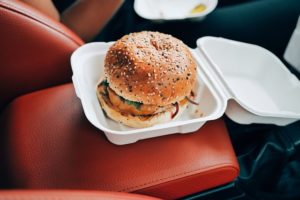Eating while on the go can be challenging for anyone. Choosing nutrient dense options in portions which  provide appropriate calories is a skill that must be learned and practiced. When a person has diabetes, selecting foods which will not aggravate blood sugar levels and/or heighten risks for heart disease becomes an even trickier task.
provide appropriate calories is a skill that must be learned and practiced. When a person has diabetes, selecting foods which will not aggravate blood sugar levels and/or heighten risks for heart disease becomes an even trickier task.
The United States Department of Agriculture (USDA) published a report on the health effects of eating food away from home. “The Impact of Food Away From Home on Adult Diet Quality(PDF),” shares the following:
- Calorie intake increases
- Consumption of fruits, vegetables, whole grains, and dairy foods decreases
- Sodium and saturated fat intakes rise
Some influences for these negative health effects include:
- Price affects food choices and lower priced items may be less nutrient-rich
- Time constraints may cause healthier items to be bypassed for less healthy items easier to eat on the run
- Personal tastes and marketing efforts may tempt consumers to purchase higher calorie, less nutritious foods
For people who live with Type 2 Diabetes and the ones who support them, Ohio State University Extension provides an opportunity for online access to a course designed to assist them as they dine outside of the home and purchase food at the grocery store. The course, Dining with Diabetes: Beyond the Kitchen is open to all and registration is always open– and free!
 Sign up is easy and free: Visit go.osu.edu/DWD_BTK and click “buy now.” The course will be added to your cart for checkout at no cost. After completing the transaction, participant will be asked to create an account with campus.extension.org to take advantage of all the materials.
Sign up is easy and free: Visit go.osu.edu/DWD_BTK and click “buy now.” The course will be added to your cart for checkout at no cost. After completing the transaction, participant will be asked to create an account with campus.extension.org to take advantage of all the materials.
Planning ahead is better than looking back and having regrets. When thinking about tomorrow, decide where and when you will be eating meals and snacks. For meals at home, incorporate adequate fruits, veggies, whole grains, lean proteins, and low-fat dairy foods. When dining out, check out menus and look for smaller portions, healthy and affordable options, and supplement fresh fruit, veggies, nuts, whole grains, etc. that can be stored safely in your bag or car. Eating healthy while on the move is made more straightforward and simple when we read the menus and/or nutrition labels for nutrition information. When we are on the go, it remains important to make choices based on the health information available– not only for our sake but also for the benefit of our families.
veggies, whole grains, lean proteins, and low-fat dairy foods. When dining out, check out menus and look for smaller portions, healthy and affordable options, and supplement fresh fruit, veggies, nuts, whole grains, etc. that can be stored safely in your bag or car. Eating healthy while on the move is made more straightforward and simple when we read the menus and/or nutrition labels for nutrition information. When we are on the go, it remains important to make choices based on the health information available– not only for our sake but also for the benefit of our families.
Check out Dining with Diabetes: Beyond the Kitchen, and arm yourself with the knowledge and skills you need to make healthy choices when you are on the run and beyond the kitchen!


